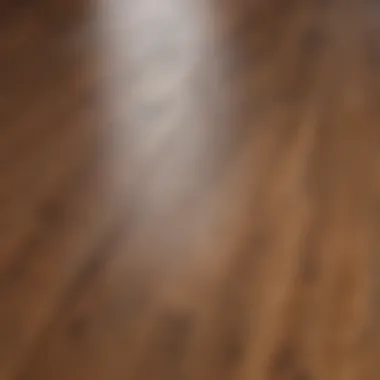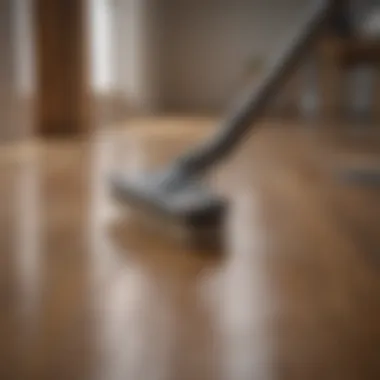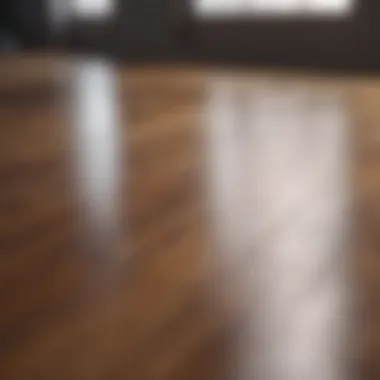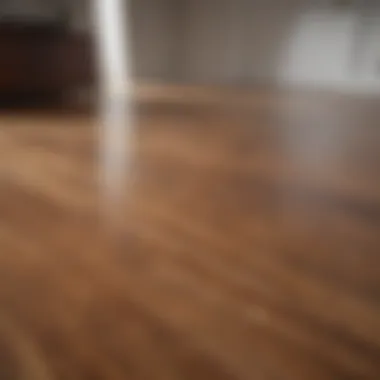Essential Techniques for Maintaining Synthetic Wood Floors


Intro
Synthetic wood floors have become a popular choice among homeowners and designers alike, combining aesthetics with practical benefits. Unlike traditional hardwood, these floors are engineered for durability, often featuring a protective layer that helps resist scratches and stains. This article advances into the depths of effective cleaning strategies tailored specifically for synthetic wood, so you can maintain that fresh-out-of-the-box look.
By understanding the unique properties of synthetic wood, you can select suitable cleaning products and techniques that won’t just shield your investment but also enhance its visual appeal. This guide is tailored to equip homeowners and design enthusiasts with insightful knowledge for routine upkeep, stain management, and prevention strategies.
Whether you're living in a chic urban loft or a serene suburban home, the insights shared here will ensure your floors dazzle for years to come.
Feature Spotlight
Exceptional Architectural Designs
Synthetic wood floors complement several architectural styles, from contemporary to traditional. Their versatility means they can adapt beautifully whether in a bustling New York City apartment or a cozy cabin in the woods. The laid-back charm paired with modern finishes presents a unique appeal.
Unique Decor Elements
Flooring often dictates the room's atmosphere, and synthetic wood plays its part splendidly. Think of it as the undercurrent that holds everything together. Intricate rugs and tasteful furniture can shine brighter against the warm tones of synthetic wood. Special collections such as Bamboo and Laminate mimic the look of actual wood while providing added benefits like moisture resistance – perfect for kitchens or bathrooms.
"Opting for synthetic wood floors doesn’t mean compromising on aesthetics. It offers elegance without the heavy maintenance of traditional woods."
Cleaning Tools and Products
When cleaning synthetic wood floors, the right tools make all the difference. Here’s what’s worth considering:
- Microfiber Mop: Ideal for dust and light cleaning.
- Soft-Bristled Broom: Helps to lift debris without scratching the surface.
- Vacuum with a Hard Floor Attachment: Efficient at removing muck without disturbing the floor’s finish.
- Mild pH-Neutral Cleaners: Such as Bona Hard-Surface Floor Cleaner.
This will ensure that dirt gets the boot while your floors remain unscathed and polished.
Routine Maintenance
Routine maintenance is key to prolonging the charm of synthetic wood floors. Follow these practices to keep them looking spick-and-span:
- Daily Sweeping or Vacuuming: Keeping dirt at bay helps to avoid scratches that can dull the surface.
- Weekly Damp Mopping: A regular damp mop with suitable cleaners can restore shine and remove any stubborn grime.
- Spot Treatment for Stains: Address spills immediately using a soft cloth and the right cleaner. Avoid harsh chemicals that might damage the finish.
Preventive Measures
Prevention is often simpler than correction. Here are some handy tips to prevent future issues:
- Use Mats at Entrances: Catch dirt before it takes residence on your floors.
- Avoid Excessive Water: Synthetic wood isn’t as absorbent as real wood, so keep it damp, not soaked.
- Footwear Rule: Consider a no-shoes rule or use soft slippers indoors.
As pages of life unfold on your synthetic wood floors, remember that each step contributes to the legacy of the space. Maintaining these surfaces with care will foster a welcoming atmosphere that entices everyone who steps through your door.
Understanding Synthetic Wood Flooring
Understanding synthetic wood flooring is central to grasping the best practices for its cleaning and maintenance. These floors mimic traditional wood in appearance and texture but are made from different materials that offer unique benefits and challenges. Knowing what synthetic wood entails helps homeowners make informed decisions about cleaning routines and products.
Composition of Synthetic Wood
Synthetic wood is primarily constructed from various materials, including high-density fiberboard (HDF), plastic, and even reclaimed wood fibers. This layering of different substances creates a robust surface that resists scratches and moisture more effectively than natural wood. For example, laminate flooring features a photographic layer of wood grain, encased in a transparent wear layer made from melamine resin.
This composition grants synthetic wood impressive durability. Unlike solid hardwood, these synthetic floors aren’t nearly as vulnerable to warping due to humidity fluctuations. They are also easier to produce, usually resulting in a lower environmental impact compared to harvesting natural timber. However, the long-term sustainability of synthetic materials is a topic of discussion among eco-conscious consumers.
Benefits of Synthetic Wood Floors
When comparing synthetic wood to its natural counterpart, several benefits emerge:
- Affordability: Generally, synthetic wood options are less expensive than solid hardwood flooring, making them more accessible for many homeowners.
- Versatility: With various designs and finishes available, it’s easier to find a synthetic option that fits specific aesthetics without breaking the bank.
- Ease of Installation: Most synthetic flooring can be installed as a floating floor system, allowing for quicker and simpler installation. This might appeal to DIY enthusiasts.
- Low Maintenance: These floors are designed to be easy to clean and maintain. They resist stains and are often treated to be water-resistant, perfect for kitchens and bathrooms.
Synthetic wood floors can dramatically enhance the appeal of a space without the hefty price tag of hardwood.
Common Misconceptions


Despite their advantages, synthetic wood floors are often misunderstood. Many people believe that they lack the warmth and charm of natural wood; however, advances in technology have allowed for incredibly realistic textures and colors. Additionally, some think that synthetic wood can't be refinished, which is somewhat correct—you can’t sand them down like hardwood, but certain higher-end laminate options can be resurfaced to some extent.
Another misconception is that synthetic woods emit harmful chemicals. While some low-quality or poorly manufactured products may release volatile organic compounds (VOCs), most reputable brands adhere to stringent safety standards, offering products that are safe for indoor use. Being informed about these misconceptions is crucial for making a sound choice regarding flooring options.
Preparation for Cleaning
When it comes to maintaining the beauty and practicality of synthetic wood floors, taking the time to prepare for cleaning is absolutely crucial. It’s like laying down the groundwork for a house; without a solid base, everything else can crumble. This stage involves a thoughtful assessment of the area, gathering the right supplies, and establishing a routine that suits your lifestyle.
Assessing the Current Condition
Before diving headfirst into the cleaning process, evaluating the current state of your floors is essential. Look for scratches, scuffs, or signs of wear.
- Is there a particular area that’s seen more foot traffic?
- Are there spots that seem to collect dirt more than others?
Understanding these issues allows you to tailor your approach accordingly. For instance, high-traffic spots may need more frequent attention or special care, while areas that have remained undisturbed might only need a light touch. This assessment can make a world of difference and ensures that your cleaning efforts are well-directed.
Gathering Necessary Supplies
Now, let’s talk about gathering everything you’ll need for this endeavor. Proper preparation can save you from racing back and forth, leaving dirt in your wake. This step involves choosing both the right cleaners and tools that match the specifics of your synthetic wood flooring.
Types of Cleaners
When you're picking cleaning products, consider what will suit your synthetic wood best. The cleaners should be gentle but effective. Look for pH-balanced solutions that won’t damage the finish of your floors. For example:
- Foaming cleaners: These lift grime without soaking the surface.
- Spray cleaners: Easy to apply directly to trouble spots.
A notable characteristic of these cleaners is that they’re designed to tackle everyday dirt without scratching or dulling the surface. However, it’s important to avoid those that contain harsh chemicals or soaps, as these can cause discoloration over time. Think of the cleaner as your partner; if it’s too abrasive, it won’t do you any favors in maintaining that pristine look.
Choosing the Right Tools
Just as important as the cleaner is the tool you use to get the job done. The right tools can make your cleaning job easier and more effective. Some recommendations include:
- Microfiber mops: Excellent for trapping dust and dirt without scratching.
- Broom with soft bristles: Ideal for sweeping up larger debris.
Choosing tools like a microfiber mop not only cleans well but also reduces the need for heavy scrubbing, which can lead to potential damage. So, think wisely about your arsenal and make sure each item has a unique contribution to the task at hand.
Establishing a Cleaning Routine
Once you've assessed the condition and gathered your supplies, the final step in preparation is setting a cleaning routine that fits seamlessly into your life. Consider factors such as your daily routines and how often your floors see foot traffic.
- Weekly dusting and light mopping are generally sufficient for most households.
- Monthly deeper cleaning can help maintain that new look.
This proactive approach not only keeps dirt at bay but also extends the life of your synthetic wood floors, ensuring they continue to look excellent for years to come. Plus, a well-planned routine minimizes the need for intensive treatments later on.
"An ounce of prevention is worth a pound of cure.” – Benjamin Franklin
In essence, preparation might seem like a chore, yet it’s a vital component of keeping your synthetic wood floors in top-notch condition. The time spent evaluating, gathering, and organizing is an investment that pays off in sparkling, durable floors.
Step-by-Step Cleaning Process
Cleaning synthetic wood floors may seem like a straightforward task, but there’s a method to the madness. The step-by-step cleaning process sets the stage for a thorough and efficient job. It ensures that dirt, grime, and other nasties don't linger, which can cause damage and dull the shine of the floor.
Following a systematic approach makes the entire process less overwhelming. Each step focuses on specific tasks, which helps in maintaining the beauty and longevity of the floor. Not only does this prevent the buildup of stains, but it also protects the flooring from premature wear. In essence, adopting a structured cleaning routine is not just about aesthetics; it’s about safeguarding your investment in synthetic wood.
Dusting and Sweeping
The first step in the cleaning process is dusting and sweeping. Just like any good chef knows, preparation is key in the kitchen, the same applies to floor care. Dust and loose debris can easily scratch surfaces when mopping later on. Therefore, taking the time to do a thorough sweeping job is crucial. A soft-bristled broom or a vacuum designed for hard surfaces works wonders. This step eliminates the surface layer of dirt, setting a clean slate for the rest of your cleaning process.
- Tip: Pay special attention to corners and under furniture – those hidden spots often gather dust bunnies faster than you can say "synthetic wood!"
Mopping Techniques


Mopping goes hand-in-hand with dusting, and both play a significant role in achieving a polished look. However, not all mopping techniques are created equal. It’s essential to understand the nuances of this seemingly simple step.
Choosing the Right Mop
When it comes to cleaning synthetic wood floors, the type of mop you choose can have a significant impact. Microfiber mops are generally regarded as an unbeatable option. They’re great at picking up dust and dirt without scratching the surface. Unlike sponge mops, which can leave excess water behind, microfiber mops allow for controlled cleaning. This controlled approach is not only effective but also prevents over-saturation of the floor, which can cause damage over time.
Mops that come with a reusable pad also align well with sustainable practices, cutting down on waste.
Water Temperature Considerations
Water temperature during mopping is another important aspect often overlooked. Warm water tends to dissolve dirt better than cold, making it easier to lift stubborn grime. However, avoid boiling water; while it may seem counterintuitive, high temperatures can damage floor finishes. A nice warm temperature is enough to aid in the cleaning process without compromising the integrity of the synthetic wood.
Spot Cleaning Stains
Even the most careful homeowners can’t avoid stains altogether. Whether it’s a drop of red wine, a muddy paw print, or a spilled drink, knowing how to address these mishaps efficiently is essential.
Identifying Different Types of Stains
Before you can treat a stain, you must know its origin. Each type of stain requires a different approach. For instance, water stains may simply need a gentle cleanser, while oil-based stains might necessitate a degreaser. By identifying the source, you can direct your efforts more intelligently, saving both time and frustration.
Effective Stain Removal Techniques
Having the right technique up your sleeve can make all the difference. Generally, starting with the mildest solution is wise. Homemade cleaners, like a mixture of water and vinegar, are often effective for many stains. For tougher spots, commercial stain removers formulated for synthetic wood can be beneficial. Just be cautious not to use abrasive materials that could lead to scratches.
Effective stain removal can often be as simple as acting fast and using the right product!
By following this step-by-step cleaning process, homeowners can maintain and enhance the beauty of their synthetic wood floors, ensuring they remain a centerpiece of their home for years to come.
Preventive Maintenance
Keeping synthetic wood floors looking new requires more than just a good cleaning routine. Preventive maintenance plays a crucial role in sustaining their appeal and prolonging their lifespan. Regular maintenance not only keeps the floors shiny but also prevents the onset of more serious issues down the line. Just like tending to a garden can keep your plants blooming, a solid preventive maintenance schedule ensures your floors flourish in their environment.
Regular Maintenance Schedule
Creating a regular maintenance schedule is essential for preventing dirt build-up and reducing wear and tear. Setting aside specific days each week for routine cleaning can make all the difference. You might want to
- Sweep or vacuum twice a week to collect dust and debris.
- Damp mop once a week, ensuring you're using a product safe for synthetic wood.
- Incorporate a deep cleaning every month or two, depending on foot traffic.
Being proactive in scheduling these tasks not only safeguards the floor's finish but also gives you a chance to inspect for any signs of damage or wear. Remember, it can be easier to fix minor issues rather than deal with major repairs later.
Using Area Rugs and Mats
Another simple yet effective technique involves strategically placing area rugs and mats in high-traffic zones. These not only enhance the aesthetics of your space but also act as protective barriers against dirt and scratches. By placing a washable rug at entryways, you can dramatically reduce the amount of grit that gets tracked onto your floors. Consider
- Choosing rugs with rubber backing to prevent slipping.
- Making sure mats are easy to clean, preferably machine washable.
Using mats reduces the frequency of deep cleaning and minimizes potential damage, ensuring that your synthetic wood floors remain both beautiful and functional.
Controlling Humidity Levels
Humidity control is often an overlooked aspect of floor maintenance. Synthetic wood, though more resilient than traditional wood, can still be affected by extreme conditions. High humidity can lead to warping or other moisture-related issues, while overly dry air can cause it to become brittle. Maintaining a balanced humidity level is key. Here are a few ways to do just that:
- Utilize a dehumidifier during peak summer months.
- Use a humidifier in winter to keep moisture levels stable.
- Regularly check humidity levels with a hygrometer to monitor changes.
Collectively, these preventive maintenance strategies go a long way in preserving the elegance of synthetic wood floors. A little attention can save you from a headache later, ensuring your floors stay in tip-top shape without breaking the bank on repairs.
Common Cleaning Mistakes
Understanding common cleaning mistakes is vital for maintaining the beauty and longevity of synthetic wood floors. These missteps aren’t just trivial; they can drastically affect the appearance and durability of your flooring. By addressing these errors upfront, homeowners can ensure they protect their investment and keep the floors looking pristine.
Using Excessive Water


One of the most prevalent mistakes with synthetic wood floors is the excessive use of water. While it might be tempting to soak your mop and assume that more water equals a cleaner floor, the reality is much different. Synthetic wood is designed to withstand moisture, but it doesn’t mean it thrives in it. Too much water can seep into seams, leading to warping or even mold growth.
- Tip: Use a damp mop rather than a sopping one. It’s crucial to wring out your mop well before tackling those stubborn spots. Just remember, a little goes a long way!
Employing Abrasive Cleaners
Another common pitfall is the use of abrasive cleaners. Many homeowners mistakenly think that tough stains need tough products. In fact, abrasive thickeners can scratch and dull the surface of synthetic wood, leaving an undesirable finish.
- Recommendation: Stick to pH-neutral cleaners specifically made for synthetic wood. These options provide efficient cleaning without compromising the integrity of your flooring. Always check the labels, as some ‘all-purpose’ cleaners may not be suitable.
Neglecting Regular Care
Lastly, neglecting regular care is a mistake that can snowball into significant problems down the line. Some homeowners might be inclined to believe that they can conduct a deep clean infrequently and all will be well. However, this is a recipe for disaster.
Regular maintenance helps keep dirt and grime from accumulating, which is pivotal not only for aesthetic reasons but also for longevity. Make it a point to establish a routine—sweeping weekly and mopping bi-weekly can yield significant results.
- Consider these steps for regular care:
- Create a cleaning schedule that fits your lifestyle.
- Use appropriate mats and rugs to trap dirt at entryways.
- Regularly inspect for signs of damage or dirt build-up.
A little prevention goes a long way; taking time to care for your floors is an investment in their future.
Being aware of these common cleaning mistakes can make a world of difference. When homeowners understand what not to do, they foster better care practices, ensuring their synthetic wood floors not only look good but stand the test of time.
When to Seek Professional Help
Taking care of synthetic wood floors usually feels like a do-it-yourself gig. However, knowing when to step back and call in the pros is just as crucial. Ignoring severe issues can lead to headaches later on, and by then, a simple cleaning could turn into a costly restoration. Proper maintenance extends the life of your floors, but recognizing the limits of at-home care is key. Several situations clearly signal that it's time to consult a professional, and understanding these can save homeowners both time and significant expense.
Identifying Severe Damage
The first step in understanding when to seek help begins with knowing what constitutes severe damage. Dings and scratches are part of everyday life, especially in homes with kids or pets. But when you start seeing deeper gouges, warping due to moisture, or extensive discoloration, it’s time to consider professional assessment. Look out for:
- Water Damage: Persistent water exposure or spills can lead to swelling and discoloration. If your floors seem to buckle or ripple, that’s a red flag.
- Loose Planks: If you start hearing creaks that weren’t there before, especially when walking, or if sections feel loose, it could mean a more serious underlying problem.
- Stubborn Stains: If you’ve tried all the tricks in your cleaning arsenal with no luck, a professional cleaner can often tackle stains that just won’t budge.
- Overall Appearance: If your floors have dulled significantly or patches look worn even after cleaning, professional refinishing may be required to restore their original beauty.
Recognizing these issues early can save not only the floors but also money in the long run. Ignoring them often leads to a more expensive fix down the line.
Understanding Restoration Options
After confirming that professional help is needed, it’s time to weigh the restoration options available. The course of action can vary significantly depending on the types of damage encountered.
- Refinishing: This process is often the go-to solution for surface damage. Professionals might sand down the top layer of synthetic wood to refresh the surface, then apply a protective sealant to keep it looking fresh. It not only beautifies the floor but extends its lifespan too.
- Replacement of Sections: If the damage is too extensive, for instance, areas that are warped or structurally compromised, individual planks might need replacing. Qualified professionals can do this while ensuring a seamless look, preserving the overall aesthetic of your space.
- Specialized Cleaning Services: Sometimes, floors might need deep cleaning beyond what standard methods can achieve. Professionals use advanced tools and products that penetrate deeper, revitalizing the floors without risking further damage.
In summary, understanding the options available when severe damage occurs can ease the decision-making process.
Choosing to consult experts not only aids in maintaining the elegance of synthetic wood floors but also preserves their integrity and longevity, ensuring you won’t face bigger issues down the line.
Remember, the key to longevity in your synthetic wood flooring is not just about cleaning but also recognizing when it’s time to seek advice from those who truly know what they're doing.
Finale
Cleaning synthetic wood floors is not just about maintaining a surface; it is about preserving the essence and longevity of your investment. Over time, these floors can accumulate dust, grime, and stains if not properly cared for. The conclusion of this article underscores the importance of implementing effective cleaning practices that are specifically tailored for synthetic wood materials, ensuring they continue to dazzle and endure.
Recap of Cleaning Practices
In this article, we've journeyed through a variety of techniques essential for keeping synthetic wood floors in top shape. Here’s a brief overview:
- Assessing Condition: Before diving into cleaning, understanding the current state of your floors provides a solid foundation to build upon.
- Supplies & Tools: Having the right tools—like a gentle mop, suitable cleaning solutions—can make all the difference.
- Step-by-Step Cleaning Process: From dusting to mopping, every step matters. Regularly sweeping away dirt paves the way for more effective cleaning.
- Preventive Maintenance: A proactive approach, through the use of rugs and humidity control, can significantly extend the life of your floors.
- Common Mistakes: Recognizing pitfalls—like over-wetting or using abrasive cleaners—helps avoid costly errors and damage.
By recalling these practices, homeowners can cultivate a routine that not only enhances the appearance of their synthetic wood floors but also their durable nature.
Final Thoughts on Synthetic Wood Care
Maintaining synthetic wood requires a mindful balance of practice and precaution. It’s a commitment, but one that yields significant benefits. Think of the longevity of your floors as a reflection of your overall home environment.
Sustaining your synthetic wood floors involves:
- Routine Care: Don’t wait for a mess to build up. A consistent cleaning schedule keeps the beauty intact.
- Learn and Adapt: Be aware of how your floors react to different cleaning agents. Adapting your methods based on your floors’ responses shows a deeper understanding of their needs.
- Invest Wisely: Quality cleaners and tools might come with a slightly higher price, but they can save money on repairs in the long run.
Remember: Properly maintained synthetic wood floors not only look beautiful but also create a healthy living environment and improve your home's value.







